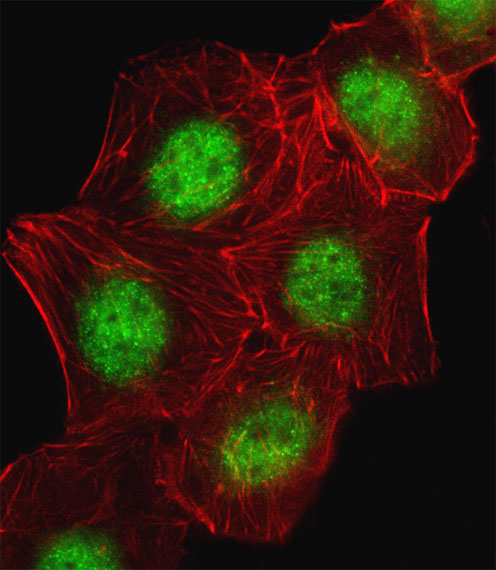CREB1 Antibody (Center)
Affinity Purified Rabbit Polyclonal Antibody (Pab)
- SPECIFICATION
- CITATIONS: 1
- PROTOCOLS
- BACKGROUND

Application
| WB, IF, FC, E |
|---|---|
| Primary Accession | P16220 |
| Other Accession | P15337, Q01147, P27925, NP_004370.1 |
| Reactivity | Human, Mouse, Rat |
| Predicted | Bovine |
| Host | Rabbit |
| Clonality | Polyclonal |
| Isotype | Rabbit IgG |
| Calculated MW | 35136 Da |
| Antigen Region | 105-132 aa |
| Gene ID | 1385 |
|---|---|
| Other Names | Cyclic AMP-responsive element-binding protein 1, CREB-1, cAMP-responsive element-binding protein 1, CREB1 |
| Target/Specificity | This CREB1 antibody is generated from rabbits immunized with a KLH conjugated synthetic peptide between 105-132 amino acids from the Central region of human CREB1. |
| Dilution | IF~~1:10~50 WB~~1:2000 FC~~1:25 |
| Format | Purified polyclonal antibody supplied in PBS with 0.09% (W/V) sodium azide. This antibody is purified through a protein A column, followed by peptide affinity purification. |
| Storage | Maintain refrigerated at 2-8°C for up to 2 weeks. For long term storage store at -20°C in small aliquots to prevent freeze-thaw cycles. |
| Precautions | CREB1 Antibody (Center) is for research use only and not for use in diagnostic or therapeutic procedures. |
| Name | CREB1 |
|---|---|
| Function | Phosphorylation-dependent transcription factor that stimulates transcription upon binding to the DNA cAMP response element (CRE), a sequence present in many viral and cellular promoters (By similarity). Transcription activation is enhanced by the TORC coactivators which act independently of Ser-119 phosphorylation (PubMed:14536081). Involved in different cellular processes including the synchronization of circadian rhythmicity and the differentiation of adipose cells (By similarity). Regulates the expression of apoptotic and inflammatory response factors in cardiomyocytes in response to ERFE-mediated activation of AKT signaling (By similarity). |
| Cellular Location | Nucleus {ECO:0000255|PROSITE-ProRule:PRU00312, ECO:0000255|PROSITE-ProRule:PRU00978, ECO:0000269|PubMed:12552083} |

Provided below are standard protocols that you may find useful for product applications.
Background
This gene encodes a transcription factor that is a member of the leucine zipper family of DNA binding proteins. This protein binds as a homodimer to the cAMP-responsive element, an octameric palindrome. The protein is phosphorylated by several protein kinases, and induces transcription of genes in response to hormonal stimulation of the cAMP pathway. Alternate splicing of this gene results in two transcript variants encoding different isoforms.
References
Jablonski, K.A., et al. Diabetes 59(10):2672-2681(2010) Bailey, S.D., et al. Diabetes Care 33(10):2250-2253(2010) Chen, G., et al. J. Neurosci. 30(39):13066-13077(2010) Serretti, A., et al. J Affect Disord (2010) In press : Melnikova, V.O., et al. PLoS ONE 5 (8), E12452 (2010) :
If you have used an Abcepta product and would like to share how it has performed, please click on the "Submit Review" button and provide the requested information. Our staff will examine and post your review and contact you if needed.
If you have any additional inquiries please email technical services at tech@abcepta.com.















 Foundational characteristics of cancer include proliferation, angiogenesis, migration, evasion of apoptosis, and cellular immortality. Find key markers for these cellular processes and antibodies to detect them.
Foundational characteristics of cancer include proliferation, angiogenesis, migration, evasion of apoptosis, and cellular immortality. Find key markers for these cellular processes and antibodies to detect them. The SUMOplot™ Analysis Program predicts and scores sumoylation sites in your protein. SUMOylation is a post-translational modification involved in various cellular processes, such as nuclear-cytosolic transport, transcriptional regulation, apoptosis, protein stability, response to stress, and progression through the cell cycle.
The SUMOplot™ Analysis Program predicts and scores sumoylation sites in your protein. SUMOylation is a post-translational modification involved in various cellular processes, such as nuclear-cytosolic transport, transcriptional regulation, apoptosis, protein stability, response to stress, and progression through the cell cycle. The Autophagy Receptor Motif Plotter predicts and scores autophagy receptor binding sites in your protein. Identifying proteins connected to this pathway is critical to understanding the role of autophagy in physiological as well as pathological processes such as development, differentiation, neurodegenerative diseases, stress, infection, and cancer.
The Autophagy Receptor Motif Plotter predicts and scores autophagy receptor binding sites in your protein. Identifying proteins connected to this pathway is critical to understanding the role of autophagy in physiological as well as pathological processes such as development, differentiation, neurodegenerative diseases, stress, infection, and cancer.




